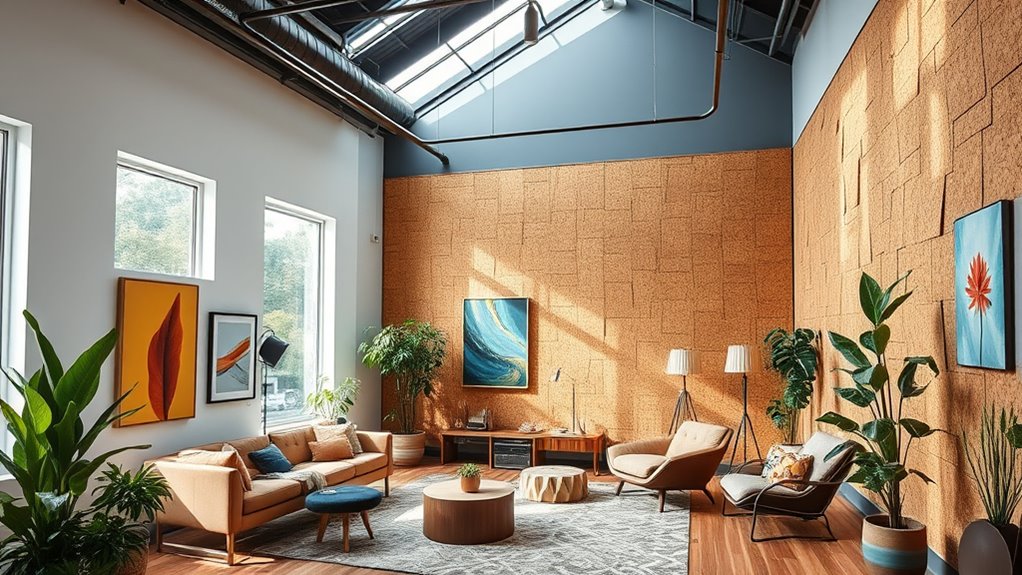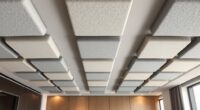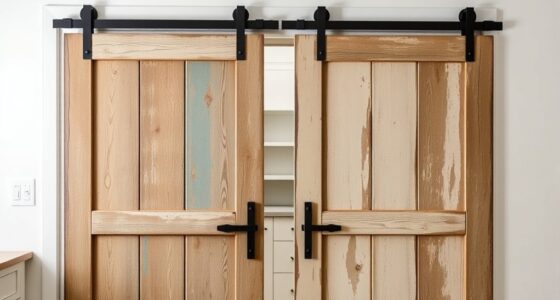A cork accent wall can markedly boost acoustics in your creative space by naturally absorbing sound waves and reducing echo. Its porous structure traps noise, creating a quieter, more focused environment. You can customize the design with colors, patterns, and textures for a vibrant look. Proper placement maximizes soundproofing, and cork’s sustainability adds an eco-friendly touch. Keep exploring to discover how to choose, install, and style your perfect cork acoustic wall.
Key Takeaways
- Cork’s porous, sound-absorbing structure effectively reduces echo and background noise in creative environments.
- Installing cork accent walls can enhance acoustic performance while adding visual interest and texture.
- Customizable patterns, colors, and textures allow for aesthetic integration and creative expression.
- Proper placement and layering with other acoustic solutions optimize noise control in busy spaces.
- Cork walls also provide thermal insulation and a sustainable design element, supporting functional and eco-friendly spaces.
Benefits of Using Cork for Acoustic Treatment
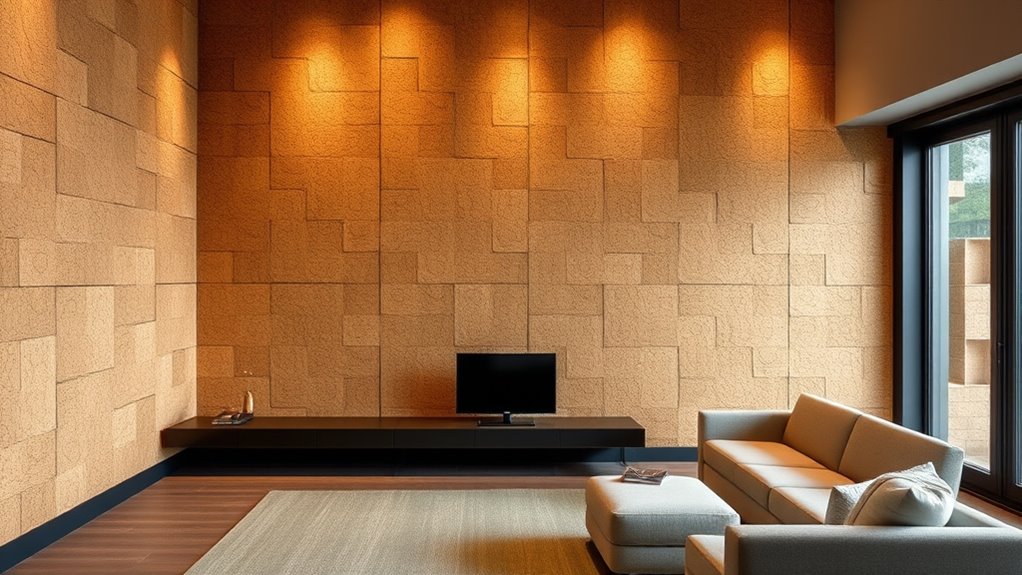
Using cork for acoustic treatment offers several notable benefits. It naturally absorbs sound waves, reducing echo and background noise, which creates a more focused environment. Cork’s porous structure traps sound energy, making spaces quieter and more comfortable for work or discussion. Additionally, cork is eco-friendly, as it’s a renewable resource harvested sustainably without harming trees. Its lightweight nature makes installation easy and versatile across different surfaces and designs. Cork also provides thermal insulation, helping to regulate temperature and improve energy efficiency. Its fire-resistant properties add an extra layer of safety in creative spaces, further contributing to a secure environment. Beyond functionality, cork adds a warm, textured aesthetic that enhances creative spaces. Its durability means it maintains its acoustic and visual qualities over time, making it a cost-effective choice. Furthermore, cork’s ability to modulate sound can be especially beneficial in creative spaces, providing an ideal environment for brainstorming and collaboration. For example, cork’s unique cellular structure also contributes to its moisture regulation, which helps maintain an optimal indoor environment. The sound absorption qualities of cork make it a preferred material for various interior applications beyond acoustic panels, including wall coverings and furniture accents. Its natural composition also plays a role in reducing indoor air pollution, contributing to healthier indoor air quality. Overall, cork offers a sustainable, stylish, and practical solution for improving acoustics in any environment.
Design Ideas for Cork Accent Walls in Creative Environments
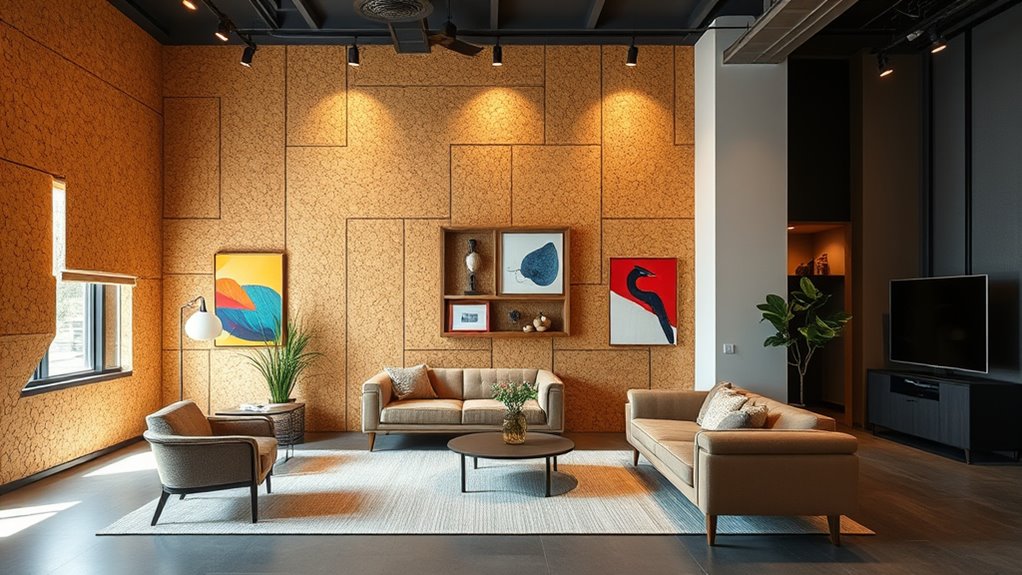
You can choose from a variety of colors and patterns to make your cork accent wall stand out and reflect your style. Creative wall layouts, like geometric or mosaic designs, add visual interest and uniqueness to your space. Plus, cork’s acoustic benefits make it a functional choice for environments that need both style and sound control. Incorporating sound absorption qualities can help create a more comfortable and productive environment. Incorporating rustic decor elements can further enhance the natural and warm ambiance of your creative space.
Color and Pattern Varieties
Cork accent walls offer a versatile canvas for exploring a variety of colors and patterns that can transform any creative space. You can choose natural cork tones for a warm, earthy feel or opt for bold, painted finishes to add vibrancy. Patterns such as geometric shapes, chevrons, or abstract designs can create visual interest and reflect your personality. If you prefer a subtle look, consider blending different shades of cork for a textured, layered effect. For a more playful vibe, incorporate printed or digitally designed cork panels with artistic motifs. Mixing colors and patterns allows you to customize your space, making it inspiring and uniquely yours. Additionally, texture variety in cork enhances both acoustics and visual appeal, giving your environment a dynamic and engaging atmosphere. Incorporating different color options can further tailor the ambiance to match your creative style and needs, especially as remote work increasingly emphasizes personalized and functional environments.
Creative Wall Layouts
Creative wall layouts can dramatically enhance the impact of a cork accent wall in any inspiring space. Instead of a plain, single-panel design, consider arranging cork tiles in geometric patterns like chevrons, herringbones, or staggered rows to add visual interest. You can also experiment with asymmetrical layouts, combining different shapes or sizes for a dynamic look. Incorporate modular panels that can be shifted or rotated over time, allowing flexibility and evolving aesthetics. For a more artistic approach, create focal points by framing sections with contrasting materials or colors. Vertical or horizontal stripes can elongate or widen a space, respectively. Play with layering textures or integrating shelving and display areas within the cork wall to serve both aesthetic and functional purposes. Additionally, exploring different cork tile arrangements can optimize acoustic performance while enhancing visual appeal. Considering the benefits of soundproofing, these layouts can also contribute to better acoustics in creative environments.
Functional Acoustic Solutions
Incorporating cork accent walls into creative spaces not only boosts visual appeal but also considerably improves acoustics. Cork’s natural sound-absorbing properties help reduce echoes and noise levels, creating a more focused environment. To maximize these benefits, consider installing cork panels with varying textures or thicknesses, which can diffuse sound waves more effectively. Combining cork with other acoustic materials like fabric or foam can further enhance sound insulation. Placement matters—position your cork wall strategically, such as behind workstations or in open areas prone to noise. Additionally, framing cork panels with sleek, modern borders can improve durability while maintaining aesthetic appeal. These functional solutions ensure your creative space remains inspiring and quiet, fostering productivity without sacrificing style. Exploring soundproofing techniques can help optimize acoustic performance in your environment. Incorporating acoustic design principles during installation can also ensure the space functions efficiently, especially when considering core sound-absorbing materials. Using sound-absorbing panels made from cork is an effective way to enhance the acoustic quality of your space naturally.
Choosing the Right Type of Cork Material

Choosing the right type of cork material is vital to guarantee your accent wall looks great and lasts. First, decide between natural cork, which offers excellent sound absorption and a warm, authentic appearance, or cork veneer, a thinner option that’s easier to install and more budget-friendly. If durability is a priority, opt for cork panels with a protective coating to resist moisture and scratches. For a more eco-friendly choice, look for cork harvested sustainably without harming cork oak trees. Consider the thickness as well; thicker cork provides better soundproofing, but may be heavier and more challenging to install. Additionally, understanding material properties can help you select materials that support smart, adaptable acoustic solutions for your space. It’s also important to evaluate the water resistance of the cork, especially if the wall is in a humid environment, to ensure longevity. Incorporating sound absorption qualities into your decision can optimize acoustic performance and create a more comfortable environment. For instance, selecting a type with high density can greatly enhance soundproofing. Lastly, check the backing material—adhesive-backed cork simplifies installation, while tiles might require additional adhesives. Picking the right type ensures your wall delivers both ideal acoustics and aesthetic appeal.
Step-by-Step Guide to Installing a Cork Wall

To install your cork wall effectively, start by gathering all the necessary materials, including cork panels, adhesive, and tools. Next, verify the wall surface is clean, dry, and smooth to guarantee a strong bond. Additionally, consider the celebrity lifestyle insights to ensure your space reflects a stylish and personalized environment. Finally, attach the cork panels carefully, making sure they are aligned and secured properly for a seamless finish.
Gather Necessary Materials
Before you start installing your cork wall, gather all the necessary materials to guarantee a smooth process. Having everything on hand prevents delays and mistakes. You’ll need cork tiles, adhesive or mounting strips, a utility knife, a ruler, a level, and a pencil for marking. Confirm the cork tiles are the desired thickness and color for your space. Having the right tools makes aligning and cutting tiles easier, resulting in a professional finish. Here’s a quick overview:
| Material | Purpose | Notes |
|---|---|---|
| Cork tiles | Cover surface for sound absorption | Choose the right size and style |
| Adhesive / Strips | Secure tiles to wall | Strong, removable if needed |
| Cutting tools | Trim tiles for perfect fit | Utility knife, ruler, level |
Gather these to streamline your installation process.
Prepare Wall Surface
Start by inspecting your wall surface to guarantee it’s clean, dry, and smooth. Any dirt, dust, or grease can prevent the cork from adhering properly. If there are bumps or uneven areas, sand them down to create a flat surface that ensures a seamless look. To prepare effectively, focus on these key steps:
- Clean the wall thoroughly with a damp cloth to remove dust and debris.
- Repair any holes or cracks using spackle or filler, then sand smooth once dry.
- Ensure the wall is completely dry before starting the installation process.
Taking these precautions will help your cork wall stay securely in place and look professional. Proper preparation sets the foundation for a successful, long-lasting installation.
Attach Cork Panels Properly
Once your wall is properly prepared, attaching the cork panels becomes a straightforward process. Begin by measuring and marking where each panel will go, ensuring even spacing and alignment. Apply a strong adhesive, like a construction glue, to the back of each panel, spreading it evenly with a notched trowel. Press the cork firmly onto the wall, holding it in place for a few seconds to ensure good contact. Use a level to verify that each panel is straight before moving on. For added security, you can use finishing nails or small brad nails at the edges, but avoid overusing them to prevent damage. Continue this process until the entire wall is covered, wiping away any excess glue immediately.
Enhancing Sound Absorption With Proper Placement
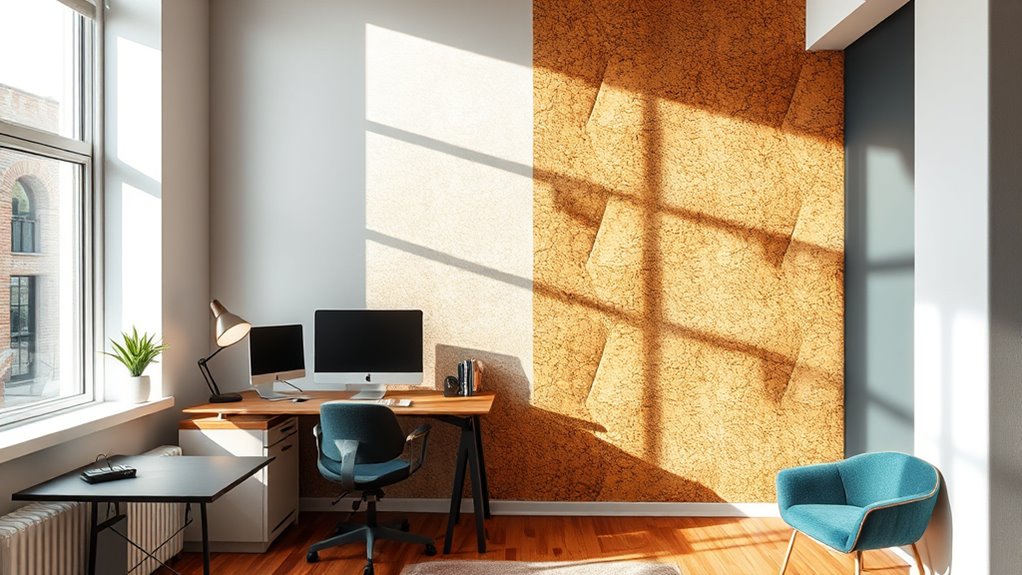
Proper placement of your cork accent wall is key to maximizing its sound-absorbing benefits. Positioning it in strategic spots can markedly improve your space’s acoustics. To do this effectively:
- Place the wall opposite or adjacent to noise sources like doors or windows to block sound transmission.
- Mount it at ear level or slightly above where conversations or work happen most frequently.
- Cover large wall areas rather than small sections, ensuring ample surface for sound absorption.
Combining Cork Walls With Other Acoustic Solutions
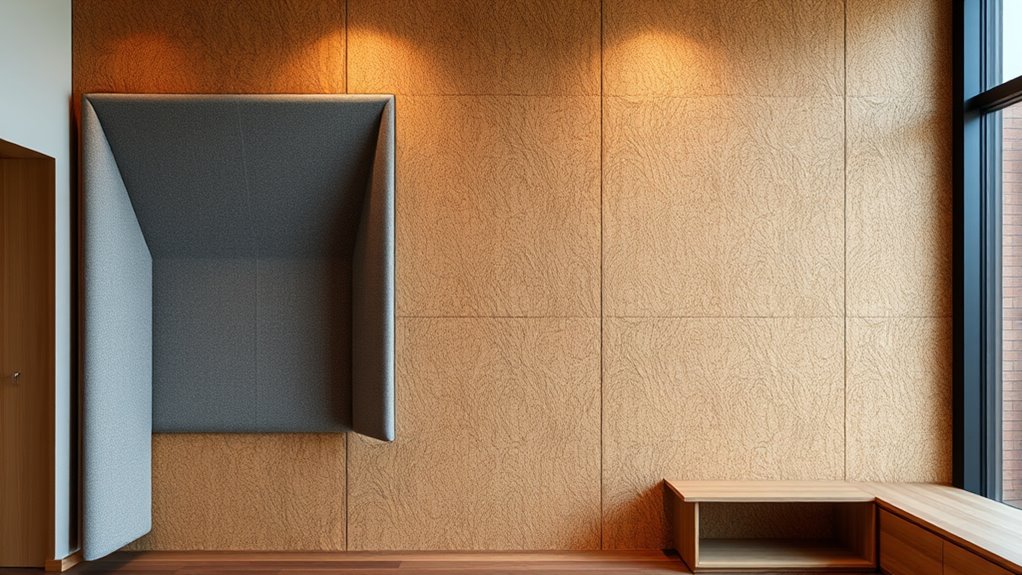
To maximize your space’s soundproofing, combining cork walls with other acoustic solutions can be highly effective. Integrate materials like acoustic panels or foam tiles on ceilings and walls to target different sound frequencies. Rugs and heavy curtains can absorb sound reflections and dampen noise transmission. Using bass traps in corners helps control low-frequency sounds that cork alone might not fully address. Installing diffusers can scatter sound waves, creating a more balanced acoustic environment. Combining these solutions with your cork accent wall ensures thorough sound management, reducing echo and background noise. This layered approach enhances the overall sound quality in your creative space, making it more comfortable and functional for work, collaboration, or relaxation.
Maintaining and Caring for Your Cork Wall
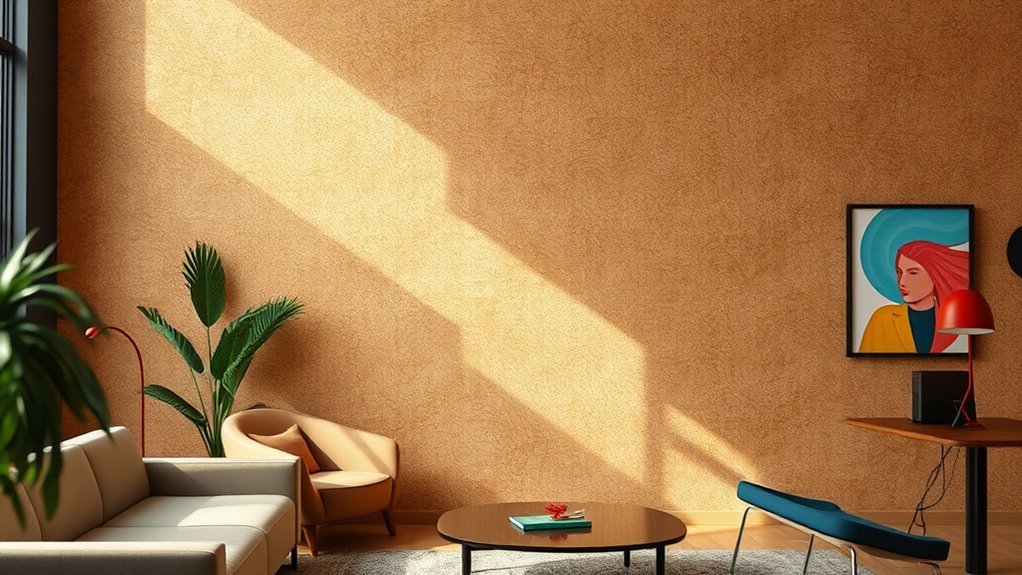
After integrating your cork wall with other acoustic solutions, maintaining its appearance and functionality becomes important. To keep it looking great and performing well, follow these simple steps:
- Clean regularly with a soft, damp cloth to remove dust and dirt without damaging the surface.
- Avoid harsh chemicals or abrasive cleaners, as they can degrade the cork’s natural properties.
- Address spills immediately by blotting gently with a dry cloth, preventing stains or water damage.
Environmental Advantages of Cork as a Sustainable Material
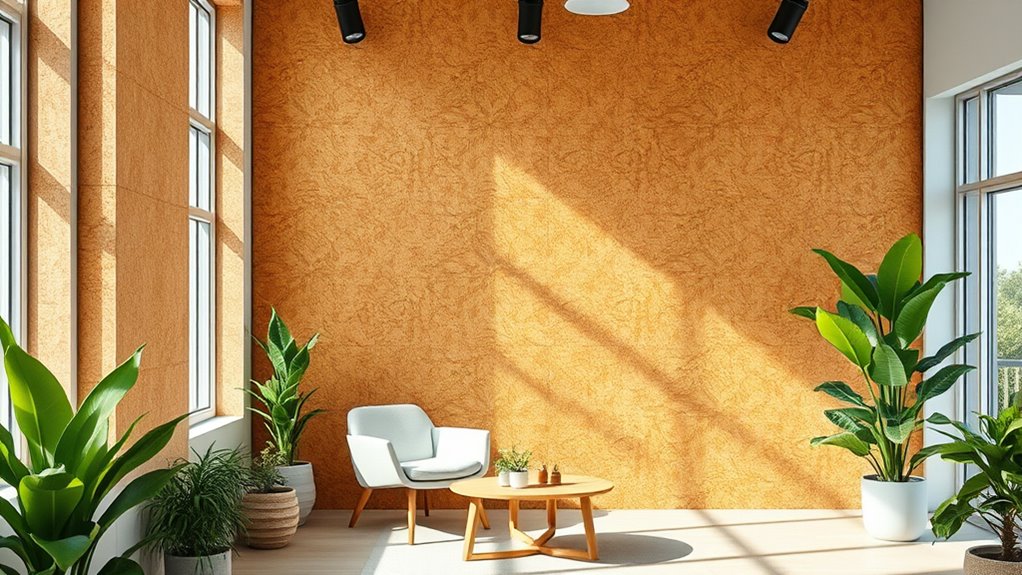
Cork stands out as a highly sustainable material because it is harvested from the bark of cork oak trees without harming them. This process allows the trees to continue growing and absorbing carbon dioxide, making cork a carbon-neutral resource. Cork harvesting occurs every nine years, ensuring a renewable supply that doesn’t deplete forests. Additionally, cork production generates minimal waste, as scraps are often recycled into other products. Cork is biodegradable, reducing long-term environmental impact. Its natural insulating properties also lower energy consumption for heating and cooling in buildings. By choosing cork for your accent wall, you support eco-friendly practices and help preserve forests. Overall, cork’s renewability, biodegradability, and low environmental footprint make it an excellent sustainable choice for creative spaces.
Customizing Cork Walls for Aesthetic Appeal
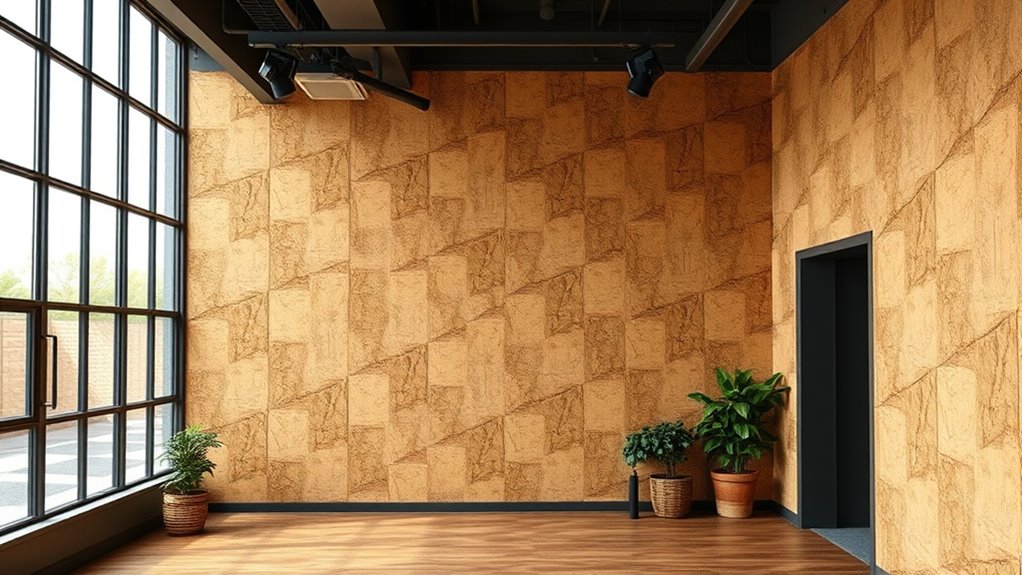
You can customize your cork wall with various materials and textures to match your style. Color options range from natural tones to bold hues, giving you plenty of choices. Plus, you can select from different patterns and designs to create a unique focal point in your space.
Material Choices and Textures
Choosing the right materials and textures can substantially enhance the visual appeal of a cork accent wall. Your material choices set the tone, from rustic to modern, while textures add depth and interest.
Consider these options:
- Smooth Finishes: Opt for polished cork panels for a sleek, contemporary look that reflects light and brightens the space.
- Textured Surfaces: Use cork with natural grain patterns or embossed textures to add tactile dimension and visual richness.
- Mixed Materials: Combine cork with wood or metal accents for a unique, eclectic style that complements your creative environment.
Color Customization Options
Ever wondered how to tailor a cork accent wall to perfectly match your space’s aesthetic? Cork panels come in a variety of colors, allowing you to choose shades that complement your décor. You can opt for natural earthy tones for a warm, organic feel or go for bold, vibrant hues to make a statement. If you prefer a more subtle look, tinting cork panels with stains or paints provides customization options without sacrificing the material’s texture. Some manufacturers offer pre-colored cork tiles, making installation quick and easy. Additionally, you can combine different shades to create patterns or accent areas, enhancing visual interest. With these options, you have full control over how your cork wall integrates seamlessly into your creative space’s overall design.
Pattern and Design Variations
Pattern and design variations transform a cork accent wall from simple to striking by adding visual interest and personality. You can experiment with different arrangements to create a unique focal point in your space.
Here are three ideas to inspire your design:
- Geometric Shapes: Use cut cork tiles to create triangles, hexagons, or chevrons, adding a modern touch.
- Mosaic Patterns: Combine different colors or textures of cork for a dynamic, eye-catching mosaic.
- Custom Art: Incorporate stenciled or carved designs that reflect your style or brand identity.
These options allow you to tailor your wall’s appearance, making it a true reflection of your creative space’s vibe. Play with patterns to enhance both aesthetics and acoustics effortlessly.
Inspiring Examples of Cork Walls in Creative Spaces
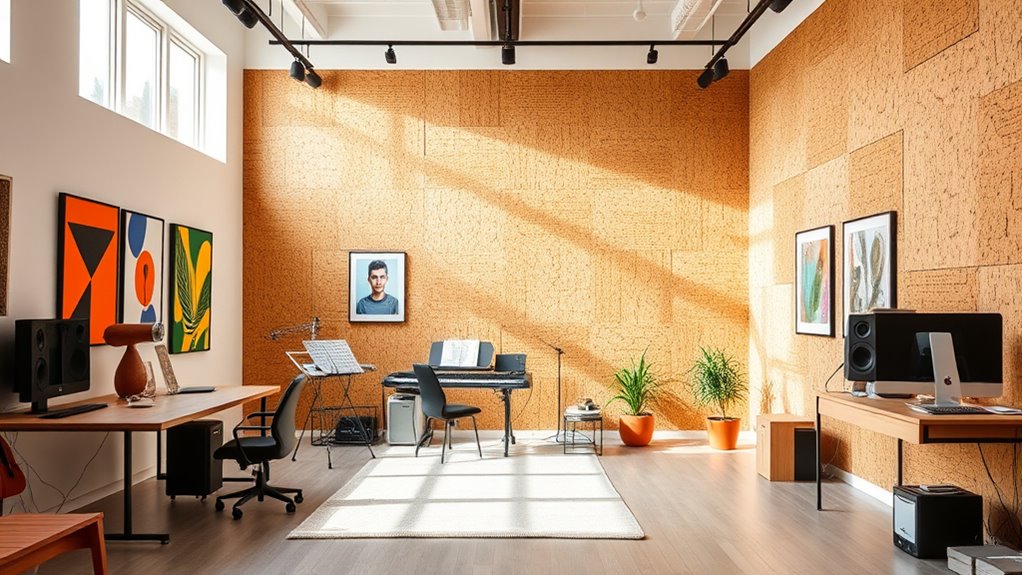
Creative spaces around the world showcase how cork walls can transform environments into inspiring hubs of innovation and expression. In coworking spaces, cork walls serve as vibrant backdrops for brainstorming sessions, fostering creativity and focus. Design studios incorporate cork panels with bold patterns, making the walls both functional and visually striking. Educational centers use cork to create acoustic zones that enhance concentration while adding a warm, inviting atmosphere. Art galleries leverage cork’s versatility for displaying artwork or mounting installations seamlessly. Even cafes and lounges integrate cork walls to craft cozy, intimate settings conducive to collaboration. These examples demonstrate cork’s adaptability, proving it’s more than just soundproofing—it’s a design feature that sparks inspiration and energizes creative workflows.
Frequently Asked Questions
How Does Cork Compare to Other Acoustic Wall Materials?
When comparing cork to other acoustic wall materials, you find cork stands out for its natural sound absorption, eco-friendliness, and aesthetic appeal. Unlike foam panels, cork offers a warmer, more inviting look and better durability. While fabric-covered panels might be more customizable, cork’s sustainable qualities and ability to improve both acoustics and ambiance make it a smart choice for creative spaces seeking a stylish, effective sound solution.
Can Cork Walls Be Easily Removed or Repositioned?
Did you know that cork is a highly versatile material, with over 90% of cork harvested coming from sustainable sources? When it comes to removing or repositioning cork walls, you’ll find it quite manageable. Cork panels often use adhesive or mounting systems that allow for easy detachment without damage, making them ideal for temporary or flexible setups. So, if your space needs to change, cork walls are a convenient choice that won’t leave a mess.
What Maintenance Is Required for Cork Acoustic Panels?
You might wonder what maintenance cork acoustic panels need. Typically, you should dust them regularly with a soft cloth or vacuum using a brush attachment to keep dust and debris away. If they get stained or dirty, gently clean with a damp cloth and mild soap. Avoid harsh chemicals or soaking the cork. Periodic inspections help make certain they stay in good condition and continue to improve your space’s acoustics.
Are There Any Health Concerns With Cork Wall Installation?
When considering cork wall installation, you might wonder about health concerns. Generally, cork is a natural, non-toxic material, making it safe for indoor use. However, verify the cork is certified free of harmful chemicals or adhesives. Proper installation and ventilation help minimize any potential respiratory issues. If you have allergies or sensitivities, check product labels and opt for eco-friendly, low-VOC options to keep your space healthy.
How Does Cork Influence the Overall Interior Design Style?
They say beauty is in the eye of the beholder, and your cork accent wall truly influences your space’s style. It adds warmth, texture, and a natural vibe that complements modern, rustic, or eco-friendly designs. You’ll find it creates a cozy, inviting atmosphere, blending seamlessly with various interior themes. Plus, its versatility means you can customize it with paint or decor, making your space uniquely yours.
Conclusion
Transforming your space with a cork accent wall is like planting a seed of creativity and calm. As you embrace this natural material, you’ll nurture an environment where ideas flourish and noise fades into harmony. With each tap and touch, you’ll cultivate a sanctuary that inspires and soothes. Let your cork wall be the heartbeat of your creative oasis, echoing not just sound, but the vibrant spirit of innovation within you.
